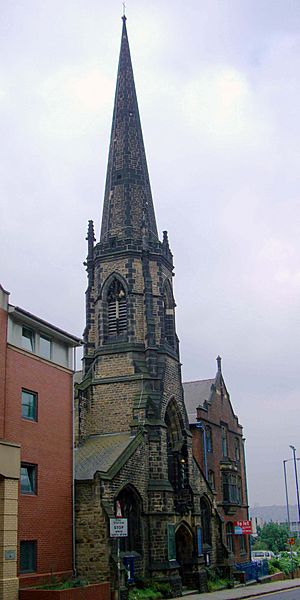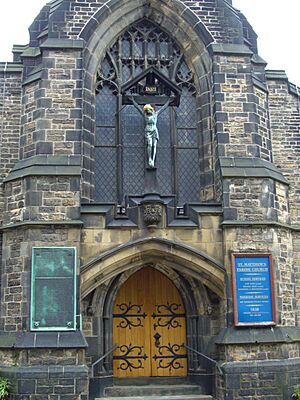St Matthew's Church, Sheffield facts for kids
Quick facts for kids St Matthew's Church, Sheffield |
|
|---|---|

St Matthew's Church, Sheffield
|
|
| OS grid reference | SK 35137 87108 |
| Denomination | Church of England |
| Churchmanship | Anglo Catholic |
| Website | St Matthew's, Sheffield |
| History | |
| Dedication | St. Matthew |
| Administration | |
| Parish | Sheffield |
| Diocese | Sheffield |
| Province | York |
St Matthew's Church, often called St Matthew's Carver Street, is a historic church in the heart of Sheffield, South Yorkshire, England. It's a special building, listed as Grade II, which means it's important and protected. The church follows the Anglo-Catholic tradition within the Church of England.
Contents
History of St Matthew's Church
Building the Church
St Matthew's Church was built in the mid-1800s. It was needed because the original Sheffield parish was divided into smaller areas in 1848. The first vicar, J.F. Witty, held early services in a school on Carver Street.
Soon, enough money was raised to build a permanent church. Land was bought for £600. The first stone was laid on June 1, 1854. The building work was done by Flockton & Son. The church was officially opened on June 6, 1855, by the Archbishop of York, Thomas Musgrave.
Early Years and Support
The church, described as "a neat building with a graceful spire," cost £3,297 to build. A generous snuff maker, Mr. Henry Wilson, gave £1,020. Other groups also helped with money. Reverend Witty worked hard to raise the rest of the funds.
In its early days, the church could seat 731 people. Many people lived nearby in a busy area. This meant the church had a large local community attending services.
The "People's Priest"
In 1882, George Campbell Ommanney became the third vicar of St Matthew's. He stayed for 54 years until he passed away in 1936. Ommanney was known as the "People's Priest." He lived in the nearby working-class areas to be close to the community.
He made St Matthew's a key place for the Catholic Revival movement in the Church of England. This movement aimed to bring back older Catholic practices into the Anglican church. Ommanney wrote about his life in a book called Ommanney of Sheffield.
Challenges and Restoration
St Matthew's Church was lucky during World War II. It was not damaged, even though many buildings nearby were hit during the Sheffield Blitz in December 1940.
In August 1956, parts of the church were damaged by fire. This included the organ and the Lady Chapel, which had just been repaired. By 1960, all the homes in the parish were replaced by shops and businesses. This meant the church no longer had people living right next to it.
In the 1970s, there were plans to build a big road that would have meant tearing down the church. Luckily, these plans were changed. In 1982, the church's two meeting rooms were improved. In 2000, the church had a major restoration. This work was funded by the Heritage Lottery Fund. Inside, old carbon from Sheffield's industrial past was cleaned from the reredos and paintings.
St Matthew's Church Today
The area around St Matthew's Church now has a growing number of residents. It is a busy church serving a lively city centre. It is surrounded by the Devonshire Quarter of Sheffield. This area has many unique shops, pubs, and bars. It also has a large student population. The church is open every day for services, visitors, and quiet prayer.
The church follows the Anglo-Catholic tradition of the Church of England. Because it has traditional views on the ordination of women, the parish receives special guidance from the Bishop of Beverley (currently The Rt Revd Stephen Race).
Architecture and Inside the Church
Outside the Church
At the front of the church, there is an eight-sided tower with a tall spire. This tower holds one bell. The main entrance is below the tower on Carver Street. Next to the main entrance is a war memorial. This plaque lists the names of people from the church and parish who died in World War I. Just above the door, there is a statue of the Crucifixion.
Next door to the church is St Matthew's House. This building used to be a home for clergy and a Sunday School.
Inside the Church
The church has three main stained glass windows. The east window, from 1886, shows the Incarnation (Jesus becoming human). It includes St Matthew and other saints. This window was designed by J. D. Sedding, who also redesigned the east end of the church at the same time, adding a new chancel. The two west windows are from 1902 and were made by Lavers, Barraud and Westlake. Other light in the church comes from clerestory windows, which are high up.
The altar and reredos (a decorated screen behind the altar) were also designed by Sedding. The carvings were done by Frank Tory, and the main painting of the Adoration is by Nathaniel Westlake. The inside of the church is beautifully decorated, with many designs by Henry Wilson.
The church organ was built in 1992 by Martin Goetze and Dominic Gwynn. It is made in the classic British style, based on the work of an old master organ builder named Bernard Smith.
See also



